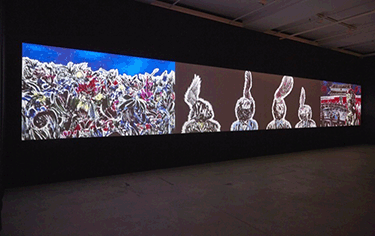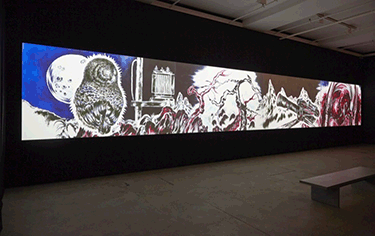When we watch animations, it’s the images that were created and tweaked by the artist, perfecting each movement, position, and color until he or she was happy with the results. Unfortunately, most of the time we only get to see the final product, losing the art that comes within the drafting stage.
Beijing artist Sun Xun held residency at the Sean Kelly Gallery in December 2014 and January 2015, using four Epson PowerLite Pro G6750WU projectors to display the animations. Photo: Jason Wyche, New York. Courtesy: Sean Kelly, New York.
Building off the idea of exhibiting the creative process, New York City’s Sean Kelly Gallery recently hosted Beijing-based animator Sun Xun (age 34) in his exhibit, The Time Vivarium, which showcases his talents leading up to a final film projected over four screens on Epson PowerLite Pro G6750WU large venue projectors.
“Sun Xun was very smart about the technology,” explained Janine Cirincione, director at Sean Kelly Gallery. “He knew from the get go that he wanted to work with these high end projectors because of the features. He needed something that would allow him to produce the images and get them up on the wall in a short time frame. In order to do that, he needed to have the confidence that he didn’t have to be playing around with the equipment.”
Occupying the gallery space for the month of December, and continuing to display the final pieces through January 24, The Time Vivarium exhibit is separated into three parts: a display of Sun Xun’s comprehensive paintings; the final animation; and the studio space itself, with leftover ink bottles, Red Bull cans and sketches, giving the viewers a glimpse into his residency.
“He is primarily a maker of moving images, however all of the art that he makes for the films can stand on its own as paintings or drawings,” explained Cirincione.
Because Sun Xun wanted to visualize the animation as he created it, Epson delivered the four PowerLite Pro G6750WU projectors early, setting them up in the studio space to project pieces of the animation as Sun Xun continued to tweak it.

By using four projectors, Sun Xun’s film, The Time Vivarium, creates a seamless narrative over all four screens, or breaks the film into segments, with each screen showing a different animation. Photo: Jason Wyche, New York. Courtesy: Sean Kelly, New York.
“The projectors are not only here for the final display, but also part of the creative process. Epson got them here very early so Sun Xun could use them,” said Ben Polsky, senior technician at Sean Kelly Gallery. “That allowed him to work up to the last minute, without being bogged down with the technology.”
Sun Xun pulls a lot of influence from traditional Chinese scroll paintings, depicting the story across the medium with images of landscape, animals, and nature. The exhibit’s final film mimics this idea, using the projectors as the scroll.
One of the major features of the Epson PowerLite Pro G6750Wu projector that attracted Sun Xun to the technology was the built-in blending technology that helped create a streamlined connection between the four screens.
“The four projectors lined up make the display look seamless, but then when the film cuts into four separate segments, you realize it’s four screens,” Polsky said.
Sun Xun also wanted to make the film room look like a traditional theater, setting up the projectors against a red velvet curtain above the viewers’ heads.
“He wanted to give them a big cinematic experience,” Polsky said.
To read more about Sun Xun’s work at the Sean Kelly Gallery, visit here.










